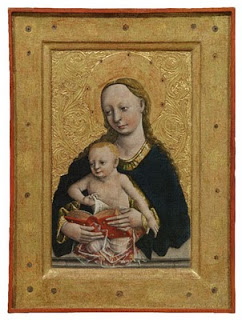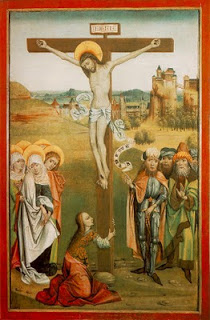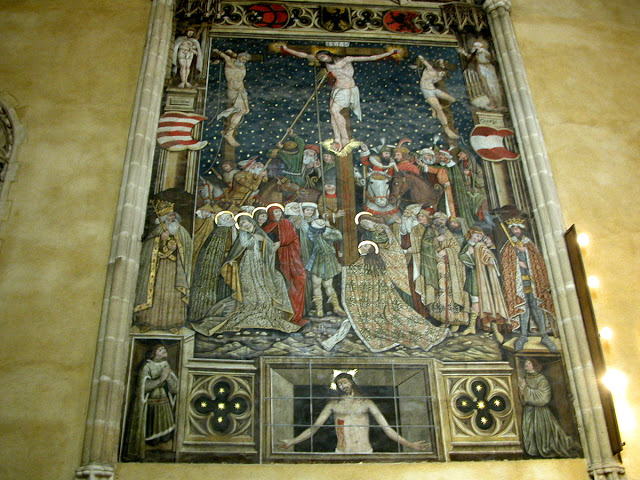Medieval History
A major exhibition, titled Van Eyck to Dürer can be seen starting from tomorrow at the Groeningemuseum in Bruges (from October 29, 2010 to January 30, 2011). The aim of the exhibition is to survey the far-reaching impact of early Netherlandish painting on Central Europe. The press release states the following:
"In the fifteenth century the Flemish Primitives triggered an artistic revolution in Central Europe. Talented painters like Jan van Eyck with his brilliant eye for detail, introduced new painting styles and techniques. Their influence spread rapidly and inspired scores of artists, including the painter, draughtsman and etcher Albrecht Dürer. Van Eyck and Dürer are two great masters from the period 1420-1530. A pioneering exhibition brings together first-rate works by them and some of their contemporaries, drawn from notable European and American collections. Paintings and other art forms will illustrate the interaction between the Flemish Primitives and art in Central Europe."
No doubt, an overview of painting in this one-hundred years should be a feast for the eye, and juxtapositions of famous works could provide numerous art historical insights. The exhibition does not seem to have an extensive website, but you can read on it at the Brugge Centraal website, of which the exhibition is part of.
In addition to focusing only on Germany, the exhibition also includes several paintings from East Central Europe. The Hungarian National Gallery is loaning a few panel painting to the exhibition, to illustrate the impact of Netherlandish painting on 15th-century Hungarian painting. The works were selected by Gyöngyi Török, who also contributed to the catalogue. Works on loan include a wing of the altarpiece from Jánosrét (Lu?ky, SK) and panels from the altarpiece of Mosóc (Mo?ovce, SK), both dating from the 1470s. Two smaller panels illustrated here - a Virgin and Child from Bártfa (Bardejov, SK) and a Man of Sorrow from Kassa (Ko?ice, SK) - are also in the exhibition.
- In Memoriam Miklós Mojzer
Miklós Mojzer in 2006 Miklós Mojzer, the former director of the Museum of Fine Arts, passed away last weekend in the 83rd year of life (1931-2014).Miklós Mojzer was an outstanding scholar of medieval and Baroque art. Born in 1931, he had studied...
- Main Altar Of Kisszeben On View Again
Photo: Hungarian National Gallery / MTI Photo: Soós LajosThe main altar of the church of Kisszeben (Sabinov, Slovakia) is on view again at the Hungarian National Gallery in Budapest. The altarpiece has not been put together since WWII - during the...
- Europa Jagellonica
The exhibition Europa Jagellonica - Art and Culture in Central Europe under the Jagiellonian Dynasty, 1386-1572 is now open at GASK - the Gallery of the Central Bohemian Region in Kutná Hora. Coordinated by Ji?í Fajt and Susanne Jaeger of...
- D'or Et De Feu
A new exhibition is coming to the Musée de Cluny (officially Musée national du Moyen Age) in Paris, titled "D'or et de feu" (Out of Gold and Fire - Art in Slovakia at the end of the Middle Ages), and opening on September 16th. The exhibition...
- Medieval Winged Altarpiece To Travel To London
After the London exhibition of the Liechtenstein collection was canceled, plans were quickly made to fill the void with an exhibition based on the holdings of Hungary's premiere art museum, the Museum of Fine Arts (Budapest). An article in the Guardian...
Medieval History
Hungarian medieval paintings exhibited in Bruges
 |
| Virgin and Child from Bártfa (Bardejov) Hungarian National Gallery, Budapest |
A major exhibition, titled Van Eyck to Dürer can be seen starting from tomorrow at the Groeningemuseum in Bruges (from October 29, 2010 to January 30, 2011). The aim of the exhibition is to survey the far-reaching impact of early Netherlandish painting on Central Europe. The press release states the following:
"In the fifteenth century the Flemish Primitives triggered an artistic revolution in Central Europe. Talented painters like Jan van Eyck with his brilliant eye for detail, introduced new painting styles and techniques. Their influence spread rapidly and inspired scores of artists, including the painter, draughtsman and etcher Albrecht Dürer. Van Eyck and Dürer are two great masters from the period 1420-1530. A pioneering exhibition brings together first-rate works by them and some of their contemporaries, drawn from notable European and American collections. Paintings and other art forms will illustrate the interaction between the Flemish Primitives and art in Central Europe."
No doubt, an overview of painting in this one-hundred years should be a feast for the eye, and juxtapositions of famous works could provide numerous art historical insights. The exhibition does not seem to have an extensive website, but you can read on it at the Brugge Centraal website, of which the exhibition is part of.
 |
| Crucifixion from the altar of Jánosrét Hungarian National Gallery |
More information is available in a tourist brochure (pdf here) and images of works to be exhibited can also be seen here. A catalogue, published in several languages and edited by Till-Holgert Borchert, should also be available starting from tomorrow (link to the German, English and French versions at Amazon).
In addition to focusing only on Germany, the exhibition also includes several paintings from East Central Europe. The Hungarian National Gallery is loaning a few panel painting to the exhibition, to illustrate the impact of Netherlandish painting on 15th-century Hungarian painting. The works were selected by Gyöngyi Török, who also contributed to the catalogue. Works on loan include a wing of the altarpiece from Jánosrét (Lu?ky, SK) and panels from the altarpiece of Mosóc (Mo?ovce, SK), both dating from the 1470s. Two smaller panels illustrated here - a Virgin and Child from Bártfa (Bardejov, SK) and a Man of Sorrow from Kassa (Ko?ice, SK) - are also in the exhibition.
 |
Man of Sorrows from Kassa (Ko?ice) Hungarian National Gallery, Budapest |
These works are perhaps not the most sophisticated examples of Hungarian painting showing the influence of Netherlandish painting. It also has to be said that this influence was for the most part not direct, as new painterly ideas were transmitted to Hungary through Germany and Austria. Finally, some of the best works in this artistic trend - including the main altars of Kassa in Upper Hungary, or Medgyes (Medias, RO) and Berethalom (Biertan/Birthälm, RO) in Transylvania - are still standing in their original location, the same spot where they have been erected in the 15th century. One of these unmovable works is, however, evoked at the Bruges exhibition. A monumental fresco of the Crucifixion in the parish church of Nagyszeben (Sibiu/Hermannstadt, RO), painted in 1445 by Johannes de Rosenau will be shown through a large-scale copy, painted at the beginning of the 20th century, and also lent by the Hungarian National Gallery. I will use this opportunity to include a photo of this fresco here (without the upper part, which was heavily repainted in the 17th century).

(I don't think I will be able to go and see this exhibition. If you have a chance to visit it - please add a comment with your impressions. Other places to see examples of medieval Hungarian paintings include the exhibitions at the Royal Academy in London and at the Musée Cluny in Paris).
- In Memoriam Miklós Mojzer
Miklós Mojzer in 2006 Miklós Mojzer, the former director of the Museum of Fine Arts, passed away last weekend in the 83rd year of life (1931-2014).Miklós Mojzer was an outstanding scholar of medieval and Baroque art. Born in 1931, he had studied...
- Main Altar Of Kisszeben On View Again
Photo: Hungarian National Gallery / MTI Photo: Soós LajosThe main altar of the church of Kisszeben (Sabinov, Slovakia) is on view again at the Hungarian National Gallery in Budapest. The altarpiece has not been put together since WWII - during the...
- Europa Jagellonica
The exhibition Europa Jagellonica - Art and Culture in Central Europe under the Jagiellonian Dynasty, 1386-1572 is now open at GASK - the Gallery of the Central Bohemian Region in Kutná Hora. Coordinated by Ji?í Fajt and Susanne Jaeger of...
- D'or Et De Feu
A new exhibition is coming to the Musée de Cluny (officially Musée national du Moyen Age) in Paris, titled "D'or et de feu" (Out of Gold and Fire - Art in Slovakia at the end of the Middle Ages), and opening on September 16th. The exhibition...
- Medieval Winged Altarpiece To Travel To London
After the London exhibition of the Liechtenstein collection was canceled, plans were quickly made to fill the void with an exhibition based on the holdings of Hungary's premiere art museum, the Museum of Fine Arts (Budapest). An article in the Guardian...
